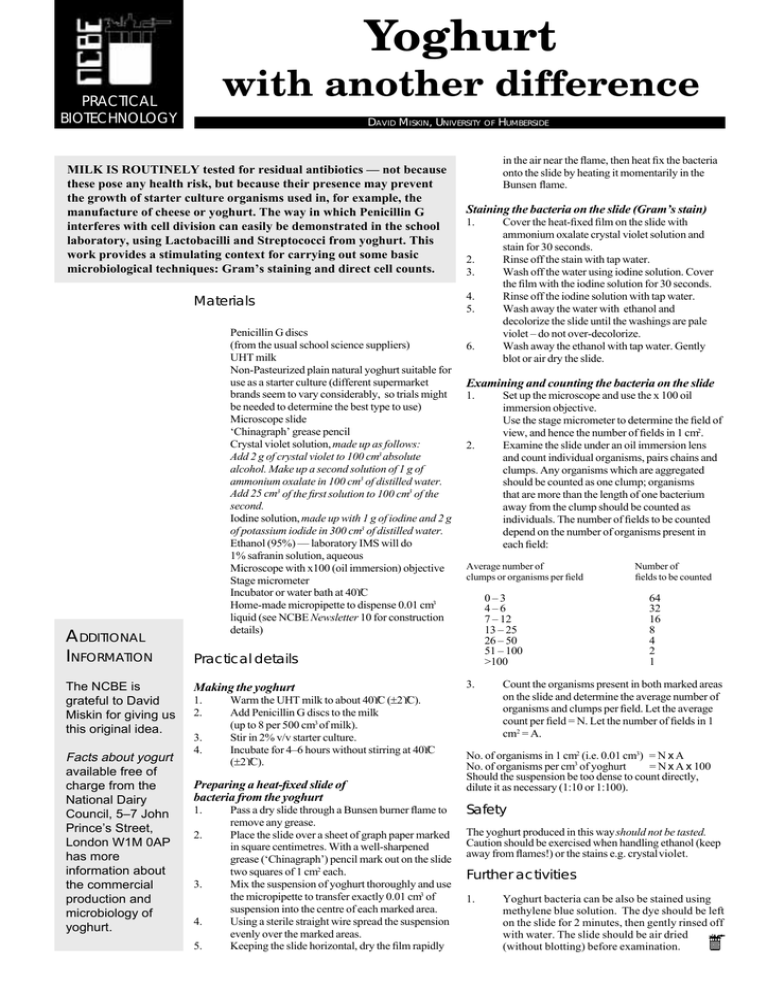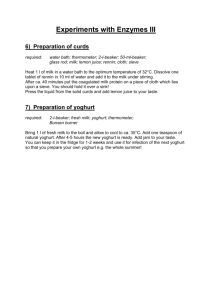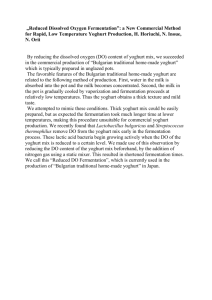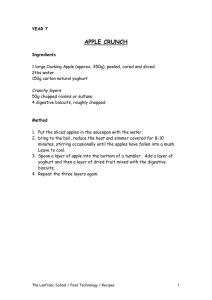Yoghurt - National Centre for Biotechnology Education
advertisement

Yoghurt with another difference PRACTICAL BIOTECHNOLOGY DAVID MISKIN, UNIVERSITY OF HUMBERSIDE MILK IS ROUTINELY tested for residual antibiotics — not because these pose any health risk, but because their presence may prevent the growth of starter culture organisms used in, for example, the manufacture of cheese or yoghurt. The way in which Penicillin G interferes with cell division can easily be demonstrated in the school laboratory, using Lactobacilli and Streptococci from yoghurt. This work provides a stimulating context for carrying out some basic microbiological techniques: Gram’s staining and direct cell counts. Materials ADDITIONAL INFORMATION The NCBE is grateful to David Miskin for giving us this original idea. Facts about yogurt available free of charge from the National Dairy Council, 5–7 John Prince’s Street, London W1M 0AP has more information about the commercial production and microbiology of yoghurt. Penicillin G discs (from the usual school science suppliers) UHT milk Non-Pasteurized plain natural yoghurt suitable for use as a starter culture (different supermarket brands seem to vary considerably, so trials might be needed to determine the best type to use) Microscope slide ‘Chinagraph’ grease pencil Crystal violet solution, made up as follows: Add 2 g of crystal violet to 100 cm3 absolute alcohol. Make up a second solution of 1 g of ammonium oxalate in 100 cm3 of distilled water. Add 25 cm3 of the first solution to 100 cm3 of the second. Iodine solution, made up with 1 g of iodine and 2 g of potassium iodide in 300 cm3 of distilled water. Ethanol (95%) — laboratory IMS will do 1% safranin solution, aqueous Microscope with x100 (oil immersion) objective Stage micrometer Incubator or water bath at 40°C Home-made micropipette to dispense 0.01 cm3 liquid (see NCBE Newsletter 10 for construction details) in the air near the flame, then heat fix the bacteria onto the slide by heating it momentarily in the Bunsen flame. Staining the bacteria on the slide (Gram’s stain) 1. 2. 3. 4. 5. 6. Examining and counting the bacteria on the slide 1. 2. 1. 2. 3. 4. Warm the UHT milk to about 40°C (±2°C). Add Penicillin G discs to the milk (up to 8 per 500 cm3 of milk). Stir in 2% v/v starter culture. Incubate for 4–6 hours without stirring at 40°C (±2°C). Preparing a heat-fixed slide of bacteria from the yoghurt 1. 2. 3. 4. 5. Pass a dry slide through a Bunsen burner flame to remove any grease. Place the slide over a sheet of graph paper marked in square centimetres. With a well-sharpened grease (‘Chinagraph’) pencil mark out on the slide two squares of 1 cm2 each. Mix the suspension of yoghurt thoroughly and use the micropipette to transfer exactly 0.01 cm3 of suspension into the centre of each marked area. Using a sterile straight wire spread the suspension evenly over the marked areas. Keeping the slide horizontal, dry the film rapidly Set up the microscope and use the x 100 oil immersion objective. Use the stage micrometer to determine the field of view, and hence the number of fields in 1 cm2. Examine the slide under an oil immersion lens and count individual organisms, pairs chains and clumps. Any organisms which are aggregated should be counted as one clump; organisms that are more than the length of one bacterium away from the clump should be counted as individuals. The number of fields to be counted depend on the number of organisms present in each field: Average number of clumps or organisms per field 0–3 4–6 7 – 12 13 – 25 26 – 50 51 – 100 >100 Practical details Making the yoghurt Cover the heat-fixed film on the slide with ammonium oxalate crystal violet solution and stain for 30 seconds. Rinse off the stain with tap water. Wash off the water using iodine solution. Cover the film with the iodine solution for 30 seconds. Rinse off the iodine solution with tap water. Wash away the water with ethanol and decolorize the slide until the washings are pale violet – do not over-decolorize. Wash away the ethanol with tap water. Gently blot or air dry the slide. 3. Number of fields to be counted 64 32 16 8 4 2 1 Count the organisms present in both marked areas on the slide and determine the average number of organisms and clumps per field. Let the average count per field = N. Let the number of fields in 1 cm2 = A. No. of organisms in 1 cm2 (i.e. 0.01 cm3) = N x A No. of organisms per cm3 of yoghurt = N x A x 100 Should the suspension be too dense to count directly, dilute it as necessary (1:10 or 1:100). Safety The yoghurt produced in this way should not be tasted. Caution should be exercised when handling ethanol (keep away from flames!) or the stains e.g. crystal violet. Further activities 1. Yoghurt bacteria can be also be stained using methylene blue solution. The dye should be left on the slide for 2 minutes, then gently rinsed off with water. The slide should be air dried (without blotting) before examination. Yoghurt with another difference Natural Yoghurt Natural Yoghurt Penicillin G test discs UH TM IL Lactobacilli K Natural yoghurt – use as a starter culture Add to pre-warmed milk 500ml Streptococci Incubate at 40°C for 4 – 6 hours DO NOT TASTE! Gram’s stain Cover slide with crystal violet solution and stain for 30 seconds. Rinse stain off with tap water or distilled water from a wash bottle. 1 Remove grease from slide 2 Mark out 2 x 1cm2 squares 3 Syringe yoghurt suspension into squares Cover slide with iodine solution and stain for 30 seconds. Rinse stain off with tap water or distilled water from a wash bottle. Decolorize slide with ethanol (IMS) until the washings are a very pale violet. Rinse with tap water or distilled water from a wash bottle. Counter stain with safranin solution for 2 minutes. Rinse stain off with tap water or distilled water from a wash bottle. 4 Dry slide over Bunsen burner flame Blot or air dry. Examine under a microscope fitted with an oil immersion lens. 5 Apply Gram’s stain (see right) © National Centre for Biotechnology Education, 1995




